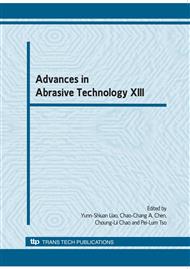p.899
p.905
p.911
p.917
p.923
p.929
p.935
p.940
p.946
Study on the Cutting Force, Temperature and Residual Stress in Milling the New Rotor Steel
Abstract:
According to the morphological characteristic of the new rotor steel, the cutting temperature and cutting forces generated by milling were investigated. The cutting temperature and forces resulted in the changes of the microstructure and residual stress of the machined surface. The tensile residual stress in the machined surface was affected more remarkably by the cutting temperature than cutting forces. In the microstructure of the machined surface, the larger plastic deformation in the machined surface and martensitic damage in the subsurface were also observed, which favored the higher tensile residual stress.
Info:
Periodical:
Pages:
923-928
Citation:
Online since:
August 2010
Authors:
Keywords:
Price:
Сopyright:
© 2010 Trans Tech Publications Ltd. All Rights Reserved
Share:
Citation:


